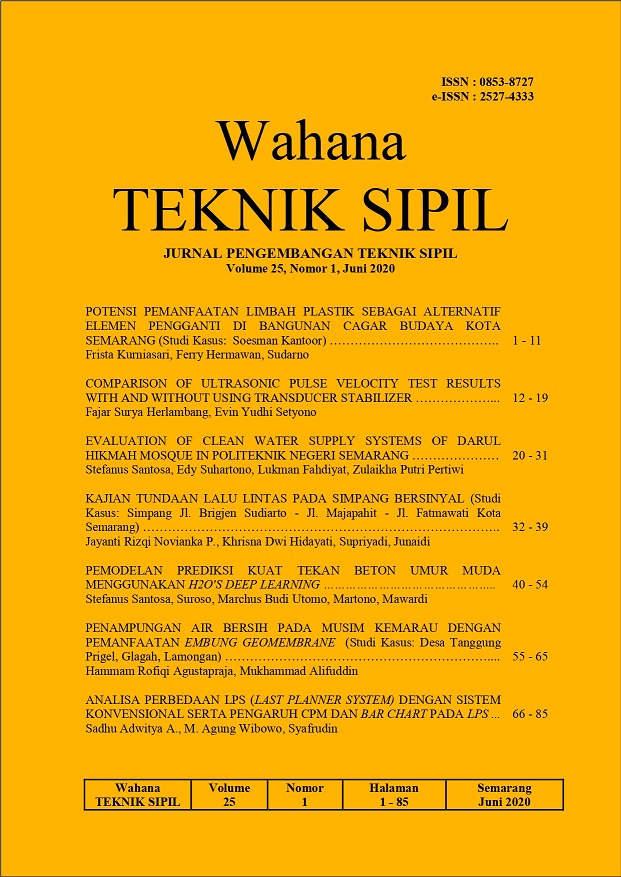EVALUATION OF CLEAN WATER SUPPLY SYSTEMS OF DARUL HIKMAH MOSQUE IN POLITEKNIK NEGERI SEMARANG
DOI:
https://doi.org/10.32497/wahanats.v25i1.1915Keywords:
clean water supply, clean water requirements, reduced pressure, water DischargeAbstract
Darul Hikmah Mosque is a building located inside Politeknik Negeri Semarang as a place of worship for all campus residents, and people who live around the area. The prayer activity is preceded by the Wudu. In order for Wudu to be carried out perfectly, sufficient quantities of water are needed. The lack of pressure and discharge of Wudu tap water, when used simultaneously, becomes a constraint that is the water pressure decreases. The purpose of this study is to determine the factors causing the lack of water discharge or pressure as required in SNI 03-7065-2005. The research method is quantitative descriptive by evaluating the performance of the existing water supply system and using a discrepancy model by comparing the evaluation results with existing data to find discrepancies. Evaluation results indicate that the factors that cause the lack of water pressure are the roof tank height is less than ideal for water distribution with gravitational power, and the volume of available water is not sufficientReferences
Araujo, L.S., Ramos, H., Coelho, S.T., 2006, Pressure Control for Leakage Minimization in Water Distribution Systems Management. Water Resources Management, Page 133-149.
Artaya, K.C.B., dan Atmaja, G.I., 2010, Perencanaan Instalasi Air Bersih dan Air Kotor Pada Bangunan Gedung dengan Menggunakan Sistem Pompa. Jurnal Ilmiah Teknik Mesin.Vol. 4, No. 1, Page 51-56.
Ingeduld, P., Pradhan, A., Svitak, Z., & Terrai, A., 2006, Modeling Intermittent Water Supply Systems with Epanet. USA, Page 1-7.
Liong, S.Y., dan Atiquzzaman, Md., 2004, Optimal Design of Water Distribution Network Using Shuffled Complex Evolution.
Singapore: Journal of The Institution of Engineers. Vol. 44, Page 93-107.
Markova, J., dan Harbul”™akova, V.O., 2016, Monitoring of water quality of selected wells in Brno district. Journal of Civil Engineering. Vol. 11, Page 31-40.
Siew, C., dan Tanyimboh, T.T., 2012, Pressure-Dependent EPANET Extension. Water Resour Manage, Page 1477-1498.
SNI 03-7065-2005. Tata Cara Perencanaan Sistem Plumbing. Jakarta: Badan Standarisasi Nasional, 2005.
SNI 03-6481-2000. Sistem Plumbing. Jakarta: Badan Standarisasi Nasional, 2000.
Wadowsky, R.M., Yee, R.B., Mezmar, L., Wing, E.J., Dowling, J.N., 1982, Hot Water Systems as Sources of Legionella pneumophila in Hospital and Nonhospital Plumbing Fixtures. Applied and Environmental Microbiology, Page 1104-1110.
Wong, L.T., Mui, K.W., 2006, Modeling Water Consumption and Flow Rates for Flushing Water Systems in High-Rise Residential Buildings in Hong Kong. Hong Kong: The Hong Kong Polytechnic University, Page 2025-2034.
Downloads
Published
Issue
Section
License
Authors who publish with this journal agree to the following terms:Authors retain copyright and grant the journal right of first publication with the work simultaneously licensed under a Creative Commons Attribution License that allows others to share the work with an acknowledgement of the work's authorship and initial publication in this journal.
Authors are able to enter into separate, additional contractual arrangements for the non-exclusive distribution of the journal's published version of the work (e.g., post it to an institutional repository or publish it in a book), with an acknowledgement of its initial publication in this journal.
Authors are permitted and encouraged to post their work online (e.g., in institutional repositories or on their website) prior to and during the submission process, as it can lead to productive exchanges, as well as earlier and greater citation of published work (See The Effect of Open Access).

